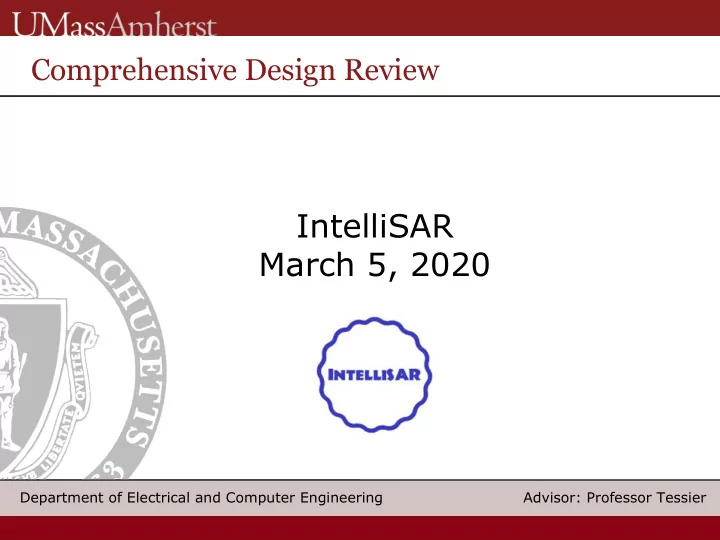

Comprehensive Design Review IntelliSAR March 5, 2020 Department of Electrical and Computer Engineering Department of Electrical and Computer Engineering Advisor: Professor Tessier 1
IntelliSAR Derek Sun Arthur Zhu Department of Electrical and Computer Engineering Department of Electrical and Computer Engineering Advisor: Professor Tessier 2
Background and Motivation ▪ Safety and information of the environment are very important aspects of rescue missions ▪ Not fully understanding the environment and situation can lead to unnecessary risks and dangers Examples: Cave/mine rescue Urban search and rescue Explorers trapped or lost Victims trapped in collapsed buildings Department of Electrical and Computer Engineering 3
Goal ▪ Provide ability to remotely examine the situation and environment ▪ Reduce possible risks or dangers ▪ Improve efficiency of rescue teams in unknown environments Department of Electrical and Computer Engineering 4
Our Product Night Vision Camera USB Accelerator Shockproof Chassis 180 Degree Gimbal Temperature/Humidity Battery Pack Sensor Non-Slip Tracks Raspberry Pi Ultrasonic Sensor 4WD Expansion Board Department of Electrical and Computer Engineering 5
Requirements Analysis ▪ Be able to be remotely controlled via Wi-Fi ▪ Be able to work in dim lighting conditions with night vision ▪ Gathered sensor data can be viewed remotely ▪ Can traverse uneven/sloped ground ▪ Be able to detect obstacles and navigate accordingly ▪ Be able to detect and classify objects Department of Electrical and Computer Engineering 6
Block Diagram Department of Electrical and Computer Engineering 7
Requirements Analysis: Specifications Specification Value Weight 6 lb Dimensions 256*183*213 mm Battery Life Board 5.8 hours Camera Night Vision 5MP Speed Range 0.7 ~ 6.5 km/h Obstacle Detection Range 3 ~ 450 cm Video Stream w/ Object H.264 640x480 @ 30FPS Detection Frame Rate Object Detection Range 6 meters (best case scenario) Department of Electrical and Computer Engineering 8
Battery Life Analysis ▪ Current peripherals consumes 800 mA in total Main Board Power Consumption Components Q’ty Current Voltage Power ▪ Raspberry Pi 4 requires 3.7V, 3A* (A) (V) (W) Raspberry Pi 1 1.1 3.7 4.1 to operate stably Camera 1 0.16 3.7 0.59 UltraSonic 3 0.015 3.7 0.06 Camera Motors 2 0.3 3.7 1.1 ▪ Very few battery banks in market USB Accelerator 1 0.5 3.7 1.85 provide 3.7V, 3A output Sum 2.375 3.7 8.9 8 Battery Life Analysis Driving Board Power Consumption Components Q’ty Current Voltage Power Components Q’ty Capacity Current Battery (A) (V) (W) (Ah) (A) Life(h) Drive Board 1 0.1 12 1.2 Wheel Motors 6 0.35 12 12.6 Battery 1 11.1 1.9 5.84 Sum 7 2.2 12 13.8 * https://www.raspberrypi.org/products/raspberry-pi-4-model-b/specifications/ Department of Electrical and Computer Engineering 9
CDR Deliverables ▪ Improve accuracy of object detection ▪ Improve speed of object detection ▪ Make semi-autonomous navigation more reliable ▪ Train model to be able to detect/classify certain objects Responsibilities ▪ Derek Sun ▪ Construct robot and restore functionality, compile training dataset, integrate USB accelerator, improve object detection, re-implement semi-autonomous navigation ▪ Arthur Zhu ▪ Compile training dataset, improve object detection, data collection and analysis, battery analysis Department of Electrical and Computer Engineering 10
CDR Deliverables: Robot ▪ Flask web application running off Raspberry Pi ▪ Robot controller ▪ Camera controller ▪ Night vision video feed w/ object detection ▪ Keyboard controls for better UX ▪ Mobile-friendly ▪ Semi-autonomous navigation enabled Department of Electrical and Computer Engineering 11
CDR Deliverables: Object Detection ▪ Implemented with Python, Tensorflow + TFLite, and OpenCV Training ▪ Transfer learning with SSD MobileNetV2 model as basis ▪ Compiled our own image database (person, rock) ▪ Used labelImg to label images labelImg (person) labelImg (rock) Department of Electrical and Computer Engineering 12
CDR Deliverables: Object Detection Detection Model Evaluation Metrics Evaluation Metric Value ▪ Tensorboard visualization tool mAP 0.4971 mAP (large) 0.5108 ▪ Provides training/eval metrics mAP (medium) 0.06634 mAP (small) 0.0016068 ▪ Detect overfitting/underfitting mAP@.50IOU 0.8607 mAP@.75IOU 0.5804 Detections Ground Truths Department of Electrical and Computer Engineering 13
Demo Department of Electrical and Computer Engineering 14
Proposed FPR Deliverables ▪ Further improve accuracy of object detection ▪ Improve robustness of robot Responsibilities ▪ Derek Sun ▪ Improve object detection accuracy, improve training dataset ▪ Arthur Zhu ▪ Robustness enhancement, improve training dataset Department of Electrical and Computer Engineering 15
Schedule Department of Electrical and Computer Engineering 16
Questions? Department of Electrical and Computer Engineering 17
Appendix: Object Detection Metrics Precision ▪ measures how accurate the model’s predictions are ▪ defined as: Recall ▪ measures how well the model finds all the positives ▪ defined as: Ex) in the context of a person detector: Department of Electrical and Computer Engineering 18
Appendix: Object Detection Metrics Intersection over Union (IoU) ▪ measures the overlap between the bounding box generated by the model and the ground truth bounding box and is what determines whether a prediction is a true positive, false positive, or false negative Average precision (AP) ▪ defined as the area under the precision-recall curve (PR curve), with the recall on the x-axis and precision on the y-axis. Mean average precision (mAP) ▪ calculated by taking the average of the AP for all the classes being predicted Department of Electrical and Computer Engineering 19
Appendix: TensorBoard Metrics mAP ▪ obtained by averaging the mAPs calculated using IoU thresholds ranging from .5 to .95 with increments of .05 mAP (large) ▪ calculated mAP for large objects (96 2 pixels < area < 10000 2 pixels) mAP (medium) ▪ calculated mAP for medium-sized objects (32 2 pixels < area < 96 2 pixels) mAP (small) ▪ calculated mAP for small objects (area < 32 2 pixels) Department of Electrical and Computer Engineering 20
Appendix: TensorBoard Metrics mAP@.50IOU ▪ mAP calculated using a IoU threshold of 50% mAP@.75IOU ▪ mAP calculated using a IoU threshold of 75% Department of Electrical and Computer Engineering 21
Recommend
More recommend